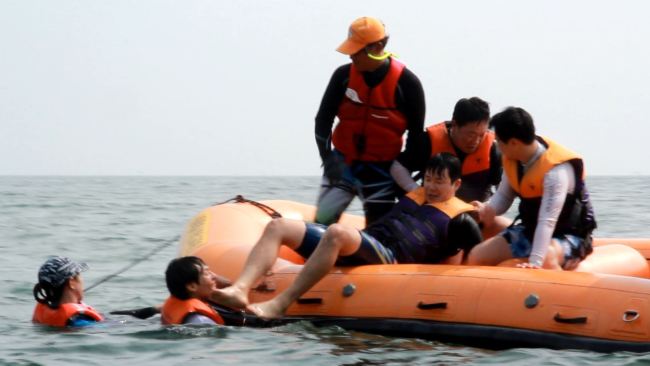Campaign on to spread basic floating skills, curb drowning deaths
By Bak Se-hwanPublished : July 30, 2017 - 15:55
Summer vacation season is in full swing, which means it is prime time for swimming.
Unfortunately, it is also the time when most drownings occur. That is where water survival classes come in.

“Basic floating techniques can prevent many deaths,” said Ryou Sun-mi, a qualified aquatic instructor and vice principal of Myeongsin Elementary School.
“But without training, children easily panic in deep water, get hypothermia and, as a result, struggle to stay afloat or tread until someone can rescue them,” Ryou said.
Drowning is one of the leading causes of accidental death in South Korea, accounting for 3,133 deaths in the last five years, according to Statistics Korea. An average of more than 600 drown to their death every year.
However, the lifesaving skills of rolling onto one’s back, floating in a position that keeps the airway clear and waiting until help arrives are not taught at schools or even at paid swimming classes that teach all the strokes from freestyle to butterfly.
To change this, the Ministry of Education has since last year been campaigning to spread water survival tips, offering teachers the chance to participate in two-day training sessions. The intention is to help teachers instruct students on how to survive in the water.
“Through the course, teachers are expected to enhance their teaching skills in water survival techniques and raise awareness of water safety,” Nam Bu-ho from the ministry said.
“In line with the training of teachers, the ministry is planning to improve students’ access to swimming facilities in cooperation with cities and provinces,” Nam said. Most public schools in South Korea do not have a swimming pool.
On July 19 at Daecheon Beach on the west coast, 60 teachers gathered under the warm, afternoon sun. Divided into groups of 10, they boarded a rubber boat to deep water, guided by an aquatic expert -- to try for themselves what they learned in theory that morning.
“Wearing a proper life jacket is critical, regardless of how well you swim. A fun swim could turn into a disaster due to conditions such as waves, currents or exhaustion,” Kim Min-soo, one of the lifeguards who led the outdoor session, said before demonstrating how to float on your front and back in the water.
Teachers also tried group-floating -- holding one another by the hands or lower arms and forming a circle while trying to hold their own upper arms tightly to their sides.
This simple and easy technique can save energy and help them stay warm while waiting for rescue, increasing the chance of survival, the instructor said.
“It is vital that you conserve energy and warmth, and the best way to do that is to use the buddy system when you are in a group,” he said.
Adopting a crouch posture when alone prevents body heat loss from such areas as head, neck, armpits and groin, according to the instructor.
Han Byung-joon, 32, one of the participants and a teacher at Jochiwon Daedong Elementary School in Sejong, said he had slipped in a pool and briefly experienced what it feels like to drown when he was a young child.
“From then on, I was just fearful. Fearful of what could happen even after so many years. I learned how to swim after that, and I want my children and students to learn how to be independent and have a gut instinct of what to do if they were in a sticky situation,” said Han.
Another teacher from Yongam Elementary School, Lee Ae-ri, said she would like to bring her students to open water for practice, not a pool.
“It’s a whole lot different in open water than in a pool. I wish the school could provide an outdoor program to teach students,” Lee said.
Water survival lessons not only allow young students to acquire skills to avoid drowning, but could lead to a rise in the popularity of swimming, said Ryou.
“Schools without swimming pools can work with local swimming centers to provide kids chances to learn how to swim with minimal fees. This in turn would make them potential swimmers in the long run,” she said.
Ryou stressed the necessity of water survival classes for adults as well. A drowning incident sparks panic for kids and adults alike, she said.
“Anybody can be under the worst case scenario, without supervision or anything to hold onto in the water, even if you are a swimmer. In such incidents, it is critical to stay calm, roll onto your back and try to breathe for a few seconds. Then look for the nearest way to get out.”
By Bak Se-hwan (sh@heraldcorp.com) and Park Ju-young (jupark@heraldcorp.com)


![[AtoZ into Korean mind] Humor in Korea: Navigating the line between what's funny and not](http://res.heraldm.com/phpwas/restmb_idxmake.php?idx=644&simg=/content/image/2024/04/22/20240422050642_0.jpg&u=)

![[Exclusive] Korean military set to ban iPhones over 'security' concerns](http://res.heraldm.com/phpwas/restmb_idxmake.php?idx=644&simg=/content/image/2024/04/23/20240423050599_0.jpg&u=20240423183955)

![[Herald Interview] Why Toss invited hackers to penetrate its system](http://res.heraldm.com/phpwas/restmb_idxmake.php?idx=644&simg=/content/image/2024/04/22/20240422050569_0.jpg&u=20240422150649)
![[Graphic News] 77% of young Koreans still financially dependent](http://res.heraldm.com/phpwas/restmb_idxmake.php?idx=644&simg=/content/image/2024/04/22/20240422050762_0.gif&u=)






![[Exclusive] Korean military to ban iPhones over security issues](http://res.heraldm.com/phpwas/restmb_idxmake.php?idx=652&simg=/content/image/2024/04/23/20240423050599_0.jpg&u=20240423183955)



![[Today’s K-pop] Ateez confirms US tour details](http://res.heraldm.com/phpwas/restmb_idxmake.php?idx=642&simg=/content/image/2024/04/23/20240423050700_0.jpg&u=)